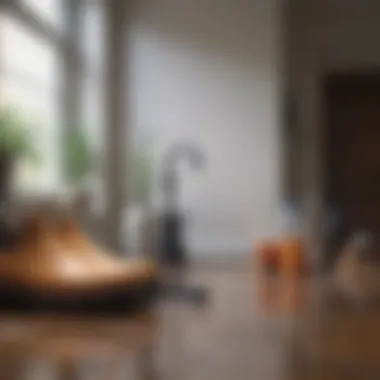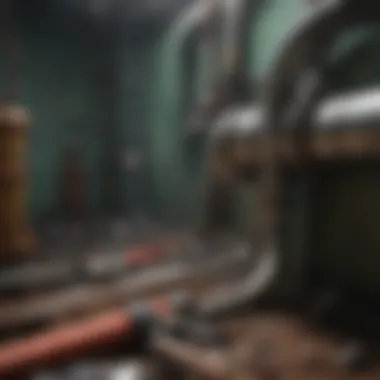Clearing Blocked Water Pipes: Effective Solutions


Intro
Blocked water pipes are more than just an inconvenience; they can lead to extensive water damage and costly repairs if not handled right away. Homeowners often find themselves facing this problem unexpectedly, disrupting daily activities. It is critical to understand the various remedies available to address these blockages effectively. This article will provide you with a detailed guide on clearing clogged water pipes, from simple household solutions to more complex professional interventions.
Understanding how to maintain a plumbing system can save you from frequent issues. Additionally, knowing the initial signs of blockage can help you respond promptly, minimizing damage and frustration. In the following sections, you will explore practical techniques, maintenance tips, and preventative measures that are essential for keeping your home’s plumbing in optimal condition.
You will also find useful insight into the right tools to have on hand when tackling these plumbing issues. Whether you are a seasoned homeowner or a new inhabitant, being equipped with this knowledge is invaluable. Clearing blocked pipes at home is not just a task; it is an essential skill that promotes overall home maintenance.
"An ounce of prevention is worth a pound of cure."
By adopting proactive measures and proper techniques, you can manage plumbing troubles effectively.
Understanding Pipe Blockages
Blocked water pipes can lead to various inconveniences in daily life. Understanding the nature of these blockages helps homeowners take action before issues escalate. When homeowners grasp how clogs develop, they can better implement solutions and maintenance practices. This section focuses on two main components: types of common blockages and the signs indicating a blockage. Recognizing these elements is critical for timely interventions, ensuring plumbing systems function optimally.
Types of Common Blockages
Understanding the types of common blockages is the first step in managing plumbing issues. Here are some prevalent culprits that often lead to clogs:
Grease Build-Up
Grease accumulation is a frequent problem in kitchen drains. Cooking oils and fats solidify over time, adhering to pipe walls.
- Key Characteristic: Grease is sticky and builds up gradually, obstructing water flow.
- Relevance: It is a common choice for attention in this article as many homeowners face this situation regularly.
- Unique Feature: Grease can be challenging to remove fully. It often requires mechanical action or strong cleaners, making it necessary for readers to learn effective removal methods.
Hair and Soap Scum
Showers and sinks are often impacted by clogs from hair and soap residue. Hair may tangle within pipes.
- Key Characteristic: Soap scum forms a sticky surface that traps hair and other debris.
- Relevance: This type of blockage is popular among households; thus, understanding its impact is crucial.
- Unique Feature: These clogs can form quickly, emphasizing the need for preventative maintenance before a major issue arises.
Foreign Objects
Accidental items like toys, dental floss, or food can obstruct pipes.
- Key Characteristic: Foreign objects often create sudden and severe blockages.
- Relevance: Addressing this issue is essential, as it can lead to expensive plumbing repairs.
- Unique Feature: The challenge lies in their unpredictable nature, and removal often requires specialized tools or services.
Mineral Deposits
In areas with hard water, mineral deposits accumulate in pipes over time. Calcium and magnesium carbonates are common culprits.
- Key Characteristic: These deposits harden and are not easily removed by typical cleaning methods.
- Relevance: Homeowners need to understand this issue to manage it effectively, which helps prolong pipe longevity.
- Unique Feature: Prevention through water softeners can be a long-term solution.
Signs Indicating a Blockage
Recognizing the signs of a blockage early can save homeowners from extensive repair costs. Here are common indicators:
Slow Drains
This is often the first noticeable sign of a blockage. Water drains slowly due to reduced flow area.
- Key Characteristic: Water pooling in the sink or shower can indicate a developing problem.
- Relevance: Slow drains are a common experience, making them an immediate consideration for readers.
- Unique Feature: Ignoring this can exacerbate the issue, leading to complete blockages.
Unpleasant Odors
Foul smells can signal decomposing material trapped within pipes.
- Key Characteristic: Musty or rotten scents often stem from organic matter.
- Relevance: This is critical for prompt action; addressing odors early can prevent more significant health hazards.
- Unique Feature: Odors often indicate that a blockage occurs, urging homeowners to check drains promptly.
Gurgling Sounds


This noise arises when air is trapped in pipes due to restricted water flow.
- Key Characteristic: Gurgling typically occurs during drainage.
- Relevance: This symptom is often overlooked but can indicate a potential blockage.
- Unique Feature: Gurgling can escalate quickly into a more serious issue if not addressed.
Backflow Issues
This occurs when wastewater flows back into drains due to pressure changes.
- Key Characteristic: Backflow can cause contamination in clean sinks or tubs.
- Relevance: Serious and detrimental, backflow signals immediate professional intervention is needed.
- Unique Feature: Homeowners must recognize that backflow is much more severe than typical blockages.
Basic Tools and Supplies
When it comes to clearing blocked water pipes, having the right tools and supplies can make all the difference. Basic tools not only simplify the process but also enhance efficacy. Furthermore, utilizing proper equipment can prevent damage to pipes, prolonging their lifespan and ensuring effective drainage. This section will delve into essential tools and safety equipment necessary for homeowners tackling plumbing issues.
Essential Tools for Homeowners
Plunger
The plunger is a staple in almost every household. Its primary function is to create suction that dislodges clogs within pipes. What makes the plunger an effective tool is its ability to work on a variety of blockages, from minor clogs in sinks to more serious issues in toilets. Its simple mechanism—pushing and pulling—means it does not require any special skills to operate effectively. However, one should be cautious when using a plunger on toilets, as incorrect technique might lead to overflow. Overall, the plunger is a powerful, yet underestimated tool for unclogging pipes.
Drain Snake
The drain snake is a more specialized tool used for serious blockages that the plunger cannot handle. It is crafted to reach deep into pipes and remove stubborn clogs, such as hair, soap scum, or foreign objects. A key characteristic of the drain snake is its flexible design, allowing it to navigate through curves and bends in plumbing systems. A notable advantage is that it can effectively clear blockages in longer or deeper pipes, which other tools might not reach. However, improper use can potentially damage pipes, so one must handle it with caution.
Baking Soda and Vinegar
Baking soda and vinegar offer a natural alternative for clearing minor clogs. This combination creates a chemical reaction that can help break down debris within pipes. The primary benefit of this method is that it is non-toxic and environmentally friendly. Additionally, it can also eliminate unpleasant odors often associated with blockages. However, this method may not be effective for large or severe clogs. It works best as a preventive measure or for small build-ups.
Wet/Dry Vacuum
A wet/dry vacuum is another powerful tool for homeowners. This versatile machine excels in both liquid and solid waste removal. It is particularly useful for large blockages, where other methods fall short. The key benefit of using a wet/dry vacuum is its ability to remove substantial amounts of debris quickly and with reduced manual effort. After use, maintenance requires simple cleaning and proper storage to extend its lifespan. However, it is crucial to follow safety protocols while operating this equipment to avoid injury or accidents.
Safety Equipment
Gloves
Wearing gloves is vital when clearing blockages. They protect hands from chemicals, bacteria, and sharp objects that may be present during plumbing repairs. Gloves provide a barrier, reducing the risk of cuts or infections. The main advantage is comfort during the cleaning process, allowing for a more meticulous approach. Disadvantages might include limited dexterity if gloves are too thick. Nevertheless, they are essential for ensuring safety while working on plumbing issues.
Goggles
Using goggles during plumbing projects is important for protecting the eyes from debris and splashes from chemicals. When clearing blockages, it is easy for irritants or sharp materials to be dislodged. Goggles are designed to prevent such incidents, making them a protective measure. They ensure a clear line of sight, boosting confidence during work. However, comfort and fit must be considered to avoid distractions during tasks.
Face Masks
Face masks are beneficial when dealing with blockages, especially if dealing with unpleasant odors or debris that may become airborne. Masks can filter out harmful particles and reduce inhalation of irritants. They are particularly useful when using chemicals, as they help prevent respiratory issues. While they are effective barriers, it's essential to choose the right type of mask for the task at hand. This ensures optimal protection during plumbing maintenance.
To successfully clear blocked water pipes, equipping oneself with the appropriate tools and safety gear is crucial. This practice not only promotes safety but also enhances effectiveness in resolving plumbing issues.
DIY Methods for Clearing Blockages
DIY methods for clearing blockages are crucial in addressing plumbing issues promptly and effectively. Homeowners often face minor yet irritating clogs that can disrupt daily tasks. Understanding these methods allows individuals to act quickly and avoid costly repairs. Doing the work themselves can save time and expenditure while fostering a sense of self-reliance. Moreover, familiarity with tools and techniques empowers homeowners to handle future issues with confidence.
Using a Plunger Effectively
Technique and Application
The technique of using a plunger is straightforward but requires some practice. To use a plunger effectively, ensure a tight seal over the drain. This helps create the necessary suction to dislodge the blockage. The key characteristic of this method is its immediacy and accessibility. It can provide instant relief from minor clogs. However, its effectiveness greatly depends on the proper technique and the type of plunger being used. Misapplication, such as not covering the overflow drain, can limit its effectiveness.
Types of Plungers
There are primarily two types of plungers: the cup plunger and the flange plunger. The cup plunger is ideal for flat surfaces like sinks, while the flange plunger has an extended rubber flange that provides a better seal on toilets. This distinction is significant as using the wrong type can lead to inadequate results. Each type has its unique features, making it a popular choice among DIYers for effectively addressing specific blockages. However, those who choose hastily may find themselves lacking better alternatives.
Common Mistakes


Common mistakes made while plunging include using too much force or not maintaining a proper grip. These missteps can damage pipes or cause splatter, creating an unsanitary situation. Among the most prevalent errors is failing to check for other potential clogs upstream. Recognizing and avoiding these mistakes can enhance the effectiveness of a plunger, making it a more reliable tool for clearing drains.
Employing a Drain Snake
Choosing the Right Drain Snake
When dealing with more stubborn clogs, a drain snake can be a useful tool. The key characteristic lies in the flexibility and length of the snake, which allows it to navigate through pipes effectively. Choosing the right size and type for the specific blockage is important. A rigid snake may not fit through tight bends, while a flexible one can adapt. This adaptability makes it a beneficial addition to any home maintenance toolkit. However, improper use can lead to pipe damage.
Step-by-Step Guide
A step-by-step guide to using a drain snake enhances the likelihood of success. Begin by inserting the snake into the drain, then rotate the handle while pushing forward to catch the clog. This hands-on approach provides clear guidance, ensuring users can follow along. Understanding and mastering this technique increases the chances of reestablishing water flow without professional help, proving this method's practicality.
Maintenance of the Tool
Regular maintenance of the drain snake is essential for its longevity. After use, ensure the tool is cleaned and stored properly to prevent rusting. A well-maintained drain snake operates more efficiently, ensuring it is ready for future clogs. Such diligence also prevents the accumulation of residue that may further complicate future plumbing issues.
Natural Solutions: Baking Soda and Vinegar
Chemical Reactions Explained
The reaction between baking soda and vinegar produces carbon dioxide, which can effectively push through minor clogs. This method is sort of a green approach to plumbing and does not expose users to harsh chemicals. Its natural composition makes it a popular choice for environmentally conscious individuals. However, it may not work for severe blockages, so understanding its limitations is key.
Application Instructions
Applying this remedy is quite simple. Pour half a cup of baking soda down the affected drain, followed by a half cup of vinegar. Let it sit for about thirty minutes before flushing with hot water. This straightforward application method is easy to follow. It allows the chemical reaction to occur without complicated processes. Its simplicity is a significant advantage, encouraging homeowners to attempt it before calling for help.
Effectiveness and Limitations
While this natural solution can tackle grease and minor blockages, it may not be effective against more severe issues. Sometimes, persistent clogs may require stronger measures. Acknowledging its limitations prevents frustration when results are not as desired, and enables better planning for addressing pipe issues.
Utilizing a Wet/Dry Vacuum
Vacuum Setup
Setting up a wet/dry vacuum for clearing clogged pipes involves a few vital steps. Ensure that the vacuum is on a stable surface and correctly configured for wet materials. This setup is essential, as improper configuration may lead to inefficiency. A properly set vacuum significantly increases its suction power, making it a practical tool for tackling stubborn clogs.
Technique for Clogs
The technique involves inserting the hose into the drain and activating the vacuum to suck out the blockage. This powerful action can dislodge materials that other methods may not reach. The strength of this option sets it apart, and users often find it effective for difficult clogs. However, it may require some skill to handle effectively, impacting those unfamiliar with vacuums.
Maintenance Post-Use
After utilizing a wet/dry vacuum, cleaning it thoroughly is necessary. This includes emptying the container and checking for debris inside the hoses. Proper maintenance prolongs the life of the vacuum and ensures it performs effectively for future tasks. By following these post-use steps, users can enhance the tool's longevity, making it a valuable investment in home maintenance.
When to Consider Professional Help
Dealing with blocked water pipes can be a frustrating experience. When DIY solutions fail or if the condition worsens, it becomes vital to consider professional assistance. Recognizing when to engage a qualified plumber is essential. Not only does it save time, it may also prevent exacerbating existing problems. Homeowners must discern specific indicators that suggest professional intervention is needed.
Identifying Severe Blockages
Signs of Serious Blockage
Signs of serious blockage often manifest as severe drain issues that are difficult to ignore. These include persistent slow draining, frequent backups, or flooding in sinks and bathtubs. Ignoring these signs can result in costly repairs down the road. Identifying severe blockages requires keen observation. Recognizing these signals allows homeowners to act before the situation escalates. Prompt action can lead to better outcomes.
Risks of DIY Attempts
While many homeowners choose DIY methods for clearing blockages, it carries certain risks. Attempting to fix significant blockages without proper knowledge may lead to pipe damage or personal injury. The use of harsh chemicals can sometimes worsen the issue instead of resolving it. Homeowners must weigh the benefits of DIY against potential downsides. Sometimes, it is best to defer to professionals who have the right expertise and tools. This minimizes risks associated with poorly executed repairs.
Importance of Professional Evaluation
Engaging a professional plumber for evaluation is critical when blockages are suspected to be severe. Professionals offer knowledge that typical homeowners may lack, leading to more accurate diagnoses. They can identify the root cause of the blockage and provide effective solutions. Moreover, professional services often include preventative maintenance advice. This foresight can help avoid future plumbing problems.
How to Select a Professional Plumber


Selecting a qualified plumber involves several steps that ensure you are hiring the right individual for the job. Considerations should include reputation, qualifications, and pricing.
Research and Reputation
Researching a plumber's reputation is essential in the selection process. Online reviews, testimonials, and referrals from friends or family can provide insights into a plumber's reliability and skill. A well-regarded professional is likely to deliver quality service and peace of mind. Furthermore, higher reputation often correlates with experience. This is a crucial aspect that homeowners need to keep in mind.
Questioning Qualifications
Asking about a plumber’s qualifications is another necessary step. Verify if they are licensed and insured. This not only reflects their professionalism but also safeguards against potential liabilities during the job. Knowing a plumber’s experience with specific issues also aids in ensuring you select someone capable of handling your unique situation. Being informed about their credentials serves to protect your investment in the repair.
Understanding Pricing Models
Finally, understanding how a plumber structures their pricing is important. Some may charge fixed rates, while others might offer hourly rates. Ensure that you receive a detailed estimate before work begins. This transparency prevents surprises and helps you make informed decisions. A clear understanding of costs is critical in maintaining your budget while addressing plumbing issues.
The right plumber can save both time and money in resolving serious blockages.
Preventative Measures for Future Blockages
Preventing blocked water pipes is essential for maintaining a functional plumbing system. Knowing how to avert these issues reduces not only inconvenience but also costs associated with repairs. Implementing effective preventative measures can prolong the lifespan of your pipes and enhance overall home hygiene.
Regular Maintenance Practices
Routine Cleaning
Routine cleaning of pipes is a vital practice for any homeowner. It prevents buildup of materials that lead to blockages, thus ensuring smooth flow of water. Clogging often begins with minor residue accumulation. Regular cleaning helps to remove grease, hair, and food particles before they turn into significant problems. This simple practice requires minimal effort and is cost-effective. Regularity in cleaning ensures that issues are caught early. Some methods include pouring boiling water down the sink and using baking soda and vinegar for more thorough cleansing.
Scheduled Professional Inspections
Scheduled professional inspections are another key component of preventative maintenance. Hiring a plumber to check your pipes at least once a year can uncover hidden issues before they become major disruptions. A professional can identify signs of wear, corrosion, or impending blockages that may not be visible to the untrained eye. This proactive approach often saves money in the long run and prevents emergency calls. The main disadvantage is the associated cost, but the peace of mind provided often outweighs this.
Awareness of Pipe Conditions
Being aware of the conditions of your pipes can aid in prevention. Homeowners should routinely inspect visible piping for signs of damage or corrosion. This includes checking for leaks or soft spots in exterior pipes. Keeping track of the age of your plumbing system and understanding its materials—copper, PVC, or galvanized steel—helps in anticipating maintenance needs. The disadvantage here is that many may overlook the finer details of their plumbing system until it’s too late. Awareness can mitigate risks by informing timely repairs and replacements.
Proper Disposal Techniques
Avoiding Grease Disposal
Properly disposing of grease is crucial in maintaining clear pipes. Pouring grease down the sink can cause serious blockages as it solidifies and binds with other debris. Instead, it is advisable to collect cooled grease in a container and discard it in the trash. This approach is simple and minimizes the risk of clogging. The main challenge for many is the habit of pouring grease down the drain, which often stems from convenience.
Managing Solid Waste
Managing solid waste responsibly is essential for preventing pipe blockages. Flushing items like wet wipes, feminine hygiene products, or cotton swabs can create serious clogs. Educating all household members about the do’s and don’ts of waste disposal can significantly reduce the risk of complications. Creating a clear disposal plan for solid waste is straightforward and highly effective. Conversely, some individuals might find it more challenging to adapt their habits to these guidelines, leading to potential future issues.
Educating Household Members
Educating household members about proper plumbing care is imperative. Ensuring that everyone understands the importance of avoiding waste disposal issues helps to maintain the integrity of the plumbing system. Simple educational efforts, such as discussions or signage near waste disposal areas, can foster a environment of awareness. This preventive measure is beneficial as it instills responsibility among all members of the home. However, continually reinforcing these principles might be necessary to make them stick.
Remember: Regular maintenance and responsible disposal techniques significantly decrease the likelihood of encountering serious plumbing issues in the future.
The End
Blocked water pipes can create much frustration and inconvenience in daily life. Recognizing the importance of a smooth plumbing system is essential for maintaining a functional home. This article serves as a detailed guide to clearing blocked water pipes. It provides homeowners with numerous methods, so that they can choose what fits their situation best.
Summary of Best Practices
When dealing with blocked pipes, documenting a few best practices is beneficial:
- Routine Maintenance: Performing regular checks and cleanings helps to prevent blockages before they arise.
- Natural Solutions: Using baking soda and vinegar is a safe, effective way to address minor clogs.
- Proper Disposal: Avoid putting grease, hair, and other undesirables down the drain. Educate all household members on these practices to minimize issues.
In the case of serious blockages, remember that sometimes the best choice is to call a professional plumber. Their expertise can efficiently resolve more complex problems.
Encouraging Responsible Maintenance
Homeowners should not underestimate the impact of responsible maintenance practices. Here are some points to consider:
- Scheduled Inspections: Regular inspections of pipes can identify vulnerabilities before they escalate into significant problems.
- Educate Household Members: By educating everyone in the house about proper disposal and maintenance, the number of blockages can significantly decrease.
- Documentation: Keeping a record of plumbing work or maintenance done can help track any issues that might arise in the future.
Taking these simple yet effective steps in managing home plumbing will have lasting effects. The aim should always be to foster a preventive mindset, rather than a reactive one, when managing plumbing systems.















